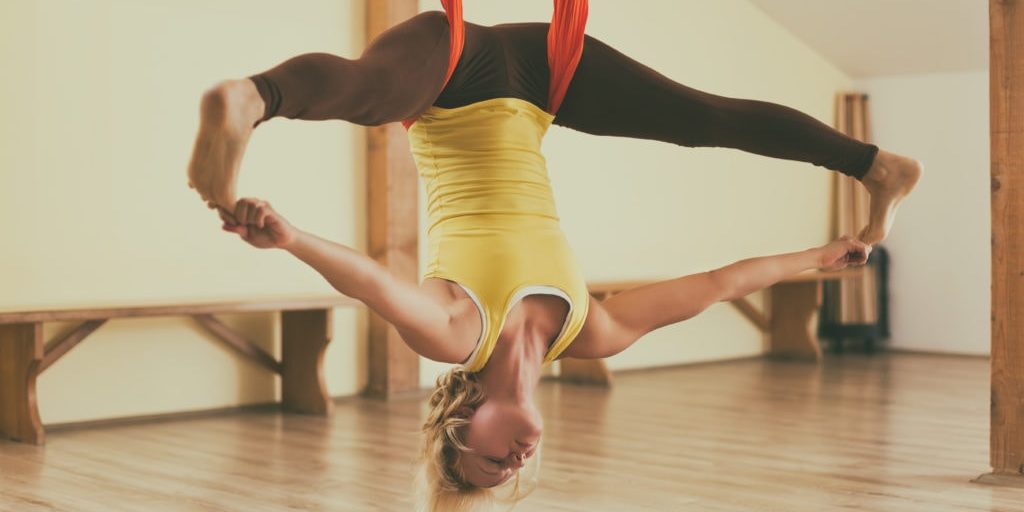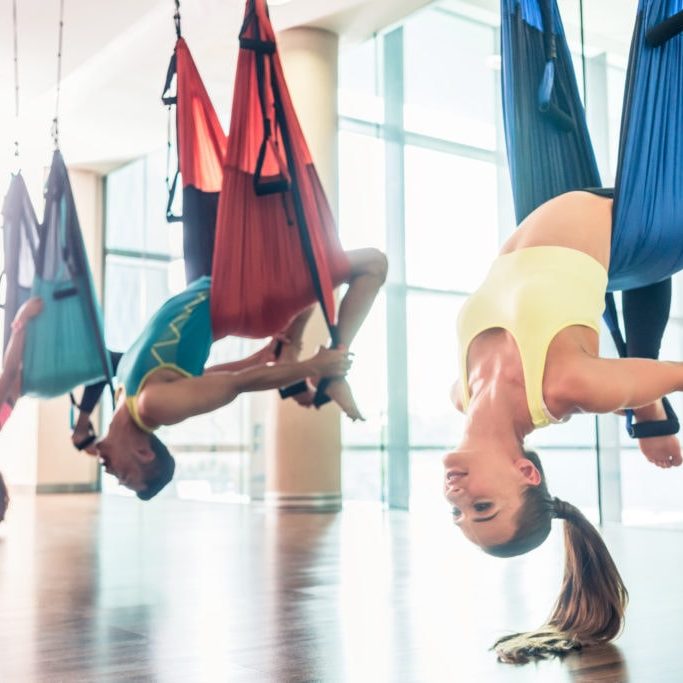Aerial Yoga
Aerial Yoga combines poses and a special hammock, suspended from the ceiling, for a class that takes place a few feet above the ground rather than on a mat. This modern yoga style increases spinal flexibility and provides support for inversions and other challenging poses, thanks to the hammock. Originally developed by dancer Christopher Harrison, in New York, Aerial Yoga is now taught around the globe.

What is Aerial yoga?
Aerial Yoga is a practice that focuses on strength and flexibility without putting any pressure on the shoulders, spine or head - due to being suspended above the ground. It’s a mixture of classical yoga and aerial arts, and like Vinyasa Flow, the poses link together and work on the entire body helping to stretch, relax the muscles and open the joints.
Breath plays a key role in Aerial Yoga with emphasis placed on when you inhale and exhale whilst moving in the hammock. Connecting with the breath helps you to transition more comfortably through the floating asanas. Having control of your breath is important because it will dictate the difference between feeling stable, and confident, in the hammock or dizzy and uncentered.
Whilst inversions are a crucial part of Aerial Yoga, the practice is also about finding balance and stillness whilst being upright and off the ground. It’s an ideal style for people with very minor injuries who want to continue practicing yoga without having to support their body weight.
In fact, the originator of this style, dancer Christopher Harrison, developed Aerial Yoga in 2007 following an injury and a trip to India where he was introduced to yoga. At first, the in-air yoga moves were used as part of the warm-up routine for Christopher’s dance troupe. However, once Christopher saw the many benefits of this flying practice he created AntiGravity Yoga, which has now morphed into Aerial Yoga.
Three central components form the basis for Aerial Yoga
- Anti-gravity
Classes are held with students suspended in air
- Flowing movement with pauses
Sequences flow from one pose to another and incorporate a pause in each asana
- Use of Ujjayi Breath
A breathing technique used in dynamic yoga styles like Ashtanga Vinyasa also guides this practice. Sometimes called ‘ocean breath’, all inhalations and exhalations are done through the nose and the distinctive rasping sound of the Ujjayi breath comes as the breath rises up from the belly, through the chest and into a slightly closed throat.
Being suspended above ground can create a sense of fear, but Aerial Yoga helps you to trust your body and its abilities. Ironically, the practice can increase a sense of grounding because being in the air makes you truly connect with your centre as you flow through the asanas.
What to expect from an Aerial Yoga session
A typical Aerial Yoga session will include strengthening and energising poses all whilst suspended above the ground. The hammock should be measured for your size to allow free movement between your body and the floor.
Like any yoga class, wear comfortable clothing that doesn’t restrict your movement. The ideal outfit is a pair of leggings, or cycling shorts, and a tight t-shirt because baggy clothing risks getting caught in the hammock. Avoid wearing jewellery, again for safety, and don’t eat anything heavy for a few hours before the session because you will be spending a lot of time hanging upside down.

A class is usually structured in the same way as a mat-based yoga practice, but it’s all done cocooned in the hammock. You will usually start with some breathwork, then a gentle warm-up, some sun salutations then go through conditioning and upper-body strengthening moves followed by core work. Finally, expect some inversions, handstands and the all-important final skydiver – where you hang upside down from your legs.
Sessions last around 60-90 minutes and include up to 10-12 key poses. Like a Vinyasa class, many teachers work up to a peak pose.
Expect to find these kinds of postures in your routine:
- Aerial Warrior II Pose – the same stance as a traditional Warrior II but both feet are supported by the hammock
- Aerial Pigeon Pose – an upright butterfly with a straight spine
- Aerial Star Pose – arms outstretched at shoulder height with both legs stretched apart to make a star shape
- Aerial Inverted Bow Pose – arching the back, opening the heart, with the head hanging towards the floor whilst the hands hold the ankles
- Aerial Cocoon – a floating Savasana

Aerial Yoga focuses on stretching the spine, so expect a lot of movements that open the heart area and elongate from the neck down to the coccyx. Don’t worry if you’re not flexible, this style is ideal for you because it aims to increase the range of movement in your back.
Your instructor will give you plenty of guidance during your session, and hands-on support, so don’t worry about getting things perfect the first time. Like all yoga styles, practice will increase your stamina and ability and there will be different options for beginners and more advanced students.
Fear can be a block to taking this type of class. But you’re less likely to fall in an inversion in Aerial Yoga than in a mat based class because a hammock is supporting you.
In fact, the hammock is the ideal way to create a sense of ease and peace. For this reason, many Aerial Yoga teachers now include a meditation practice at the end of the class and you will have the option to enjoy Savasana either in the hammock or on the floor.
However, if you have a fear or heights or vertigo then it might not be the best practice for you. Pregnant women or people who’ve had a recent major operation are also advised against doing this style of yoga.
Effects and benefits of Aerial Yoga
Traditional yoga is one of the best ways to reduce stress, find calm and strengthen the body. Aerial Yoga has the same benefits with the added bonus that you’re able to stretch and strengthen the body without putting any excess stress on your spine or joints.
A key element of this practice is the back-bending aspect – being suspended upside down. With so many people working on a computer, or hunched forward during their working day, the heart opening aspect of Aerial Yoga beautifully counteracts the forward folding position we often adopt in the West.
Some of the top benefits of Aerial Yoga include:
- Increases self-confidence and can create feelings of peace and calm
- Lowers stress and overwhelm
- Helps to build all-over body muscle and strengthens the core
- Improves flexibility especially in the spine and back
- Elongates the spine creating more space between each vertebra, which releases tension
- Due to the anti-gravity aspect, expect to go a little deeper in your stretching than on the mat
- Encourages internal heat, the yogi fire, and triggers detoxification in the body
- Inverted postures can be practiced with more ease than on a mat and often for longer resulting in a healthy blood flow to the brain
- Increases energy levels through the increased flow of blood and oxygen throughout the body
- Good for cardiovascular health and burns more calories than a traditional mat-based class
